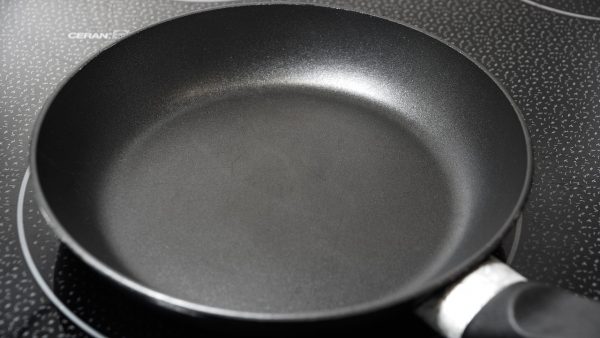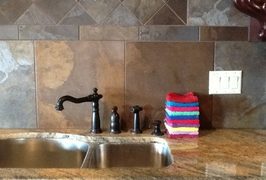Using nontoxic cleaning products is a great way to improve the air quality in your home. Sadly most commercially made cleaners are loaded with fragrance and chemicals that are known carcinogens and neurotoxins. These chemicals can contribute to respiratory problems, cause headaches, sore throat and other allergic reactions.
Switching from commercial products loaded with toxins to nontoxic homemade cleaners is so much easier than you may realize. It’s good for your wallet, your health and the planet.
Very few of us are in the position to replace things all at once. So start replacing things gradually. How you decide to do this is a matter of personal choice. Perhaps you want to start with replacing items that have the biggest negative impact on your health. Perhaps you want to start with the things that are the easiest financially to replace, or you may want to wait to replace things as they wear out. Again, there is no right answer here, it’s about what works for you.
 1. Make Your Own Cleaning Products-This is so easy. Using simple ingredients like baking soda, castile soap, vinegar and water you can make a variety of products for cleaning just about every surface in your home. Here are some links for non-toxic cleaning recipes:
1. Make Your Own Cleaning Products-This is so easy. Using simple ingredients like baking soda, castile soap, vinegar and water you can make a variety of products for cleaning just about every surface in your home. Here are some links for non-toxic cleaning recipes:
 2. Avoid Air Fresheners
2. Avoid Air Fresheners
-They are loaded with toxic ingredients that are harmful to your health and pollute the indoor air with VOCs. (1)
-Try simmering fresh organic herbs, spices or fruit slices on the stove.
-Open the window to allow some fresh air in the home.
-Use air purifiers to clean your indoor air.
-Don’t buy commercial air fresheners, make your own with essential oils. (2)
-Purchase houseplants that help to purify the air. (3)

3. Eliminate Products with Triclosan
Triclosan was registered as a pesticide in 1969. Triclosan is used to stop or slow the growth of fungus, mildew and bacteria. It has many common daily uses in products such as soaps, shampoos, toothpastes, cutting boards, antimicrobial sponges, and other antimicrobial products. So your best bet is simply to avoid any product that says “antimicrobial” on it. (4)
–Avoid products that have the term antimicrobial on the label.
-Skip disinfectants and use chemical free options to disinfect such as vinegar, GSE, vodka or silver.

4. Go BPA Free
-Skip the paper receipts from stores and ATMs, unless really necessary.
-Avoid canned products when possible and opt for fresh or frozen vegetables and fruits instead.
-Buy and store products in glass or cardboard in place of cans.

5. Skip All Fragranced Products
Sadly most fragrances are laden with toxic chemicals. (5) According to the Massachusetts Nursing Association:
-There are 3,000-5,000 chemicals used in fragrances.
-95% of these chemicals are derived from petroleum.
-Over 80% of these chemicals HAVE NOT been tested for human toxicity
-Some of these chemicals are on the EPA hazardous waste list
-The perfume industry is not regulated by any government agency
-The perfume industry is not required to disclose the ingredients in fragrance. Fragrances formulas are considered “trade secrets”. This means that the fragrance industry does not have to reveal to you or anyone else the materials in the fragrance part of a product.
-The National Academy of Sciences targeted fragrances as one of the six categories of chemicals that should be given high priority for neurotoxicity testing.
So what can you do?
-Look for products labeled fragrance free.
-Many products that are labeled as unscented actually have a masking fragrance added to “hide” odors.
-Don’t buy commercial air fresheners, make your own with essential oils.

6. Clean Up Your Personal Care Products
-Read labels and avoid products that contain fragrance, SLS, and oxybenzone.
-Check EWG’s Skin Deep Cosmetics Database to verify the ingredients in your products.

7. Keep Chemicals Out of Your Home
Many cultures have the tradition of removing your shoes before entering a home and other indoor spaces. (6)While this can help with wear and tear on your flooring, it can also help to minimize the amount of time you spend sweeping, mopping or vacuuming. It also turns out there are some excellent practical and health reasons for doing this. A study by Battelle Memorial Research Group found that chemicals used within a week of treating lawns and grass areas are easily tracked in your home. This also includes the dust and particles from recently paved or re-sealed asphalt roads and driveways. (7,8)
-Remove your shoes before walking into your home to avoid tracking in dirt and chemicals from outside.
-Keep your house closed up when neighbors are fertilizing their lawn or spraying for weeds and pests.
-Dust and vacuum frequently.

8. Toss the Non Stick Cookware
-Perfluorooctanoic acid (PFOA, also known as C8) is used to make teflon coatings for pots and pans. Many people still use them, seduced by the ease of clean up. No one should be using nonstick pans. PFOA exposure is scientifically linked to numerous illnesses including ulcerative colitis, high cholesterol, thyroid disease, heart disease, testicular cancer, kidney cancer and pregnancy induced hypertension. Pub Med has over 1,800 studies regarding PFOAs. PFOAs and related chemicals have contaminated the bodies of nearly every American, it even passes through the umbilical cord to unborn children in the womb.
-Replace Teflon coated cookware with cast iron or stainless steel pans.

9. Replace Plastic with Glass
-There are numerous studies that share how using, reheating, preparing and storing your food in plastic can adversely affect your health. BPA (Bisphenol-A the main component of plastic polycarbonates is linked to ADD, cancer, infertility and a host of other ills. (9)
In addition, plastic wraps take forever to break down and can’t be recycled. Consider some more practical, reusable options such as glass storable, reusable containers.
-Store food in glass or ceramic jars.
-Never microwave plastic containers.
-Avoid plastics numbered #3 (PVC), #6 (polystyrene), and #7 (other) which are more likely to leach toxics and are also more difficult to recycle.

10. Avoid Dryer Sheets/Fabric Softeners
Dryer sheets and fabric softeners are a health risk for anyone with asthma and any respiratory condition. The Association of Occupational and Environmental Clinics, is a leading international authority on asthma. They consider many of the chemicals in dryer sheets “asthmagens,” substances that can cause asthma to develop in otherwise healthy people. Since asthma affects 1 in 10 children, dryer sheets should be avoided. In addition they consistency out gas chemicals into the air. The chemicals are absorbed into your skin, as well as into the air you breathe. (10,11,12)
-Use a half cup of baking soda or vinegar in your wash to soften clothes.
-To avoid static electricity in the dryer, use felted wool balls.
In conclusion
We all want to be healthy and cleaning up the indoor air of our homes is a great place to start. Many nontoxic, environmentally friendly cleaning products can be made at home with inexpensive ingredients from your pantry. Always be sure to label and date your cleaning products and keep out of the reach of children. Even though they are non-toxic, you still don’t want young children or pets consuming your glass or counter cleaner.
In addition, many of these choices are also healthy for the planet. Let’s create healthy living habits for ourselves and our children, so we can leave the world a little better than we found it.
References:
- McFarland, E., N.D. (2018, February 02). Toxins in Air Fresheners. Retrieved March 01, 2018, from http://myhealthmaven.com/toxins-in-air-fresheners/
- McFarland, E., N.D. (2017, August 13). Make Your Own Non Toxic Air Freshener with Essential Oils. Retrieved March 01, 2018, from http://myhealthmaven.com/make-non-toxic-air-freshener-essential-oils/
- McFarland, E., N.D. (2016, August 19). The Top Twenty Clean Air Houseplants. Retrieved March 01, 2018, from http://myhealthmaven.com/top-twenty-clean-air-houseplants/
- McFarland, E., N.D. (2016, November 23). Triclosan & The Impact on Your Health. Retrieved March 01, 2018, from http://myhealthmaven.com/impact-triclosan-effects-health/
- Massachusetts Nurses Association 9MNA). Fragrance Free! Creating a Safe Health Care Environment. Courseserver.com 2007. http://www.courseserver.com/mna
- McFarland, E., N.D. (2017, January 30). 6 Reasons You Shouldn’t Wear Shoes Inside Your Home. Retrieved March 01, 2018, from http://myhealthmaven.com/6-reasons-shouldnt-wear-shoes-inside-home/
- Distribution of 2,4-Dichlorophenoxyacetic Acid in Floor Dust throughout Homes Following Homeowner and Commercial Lawn Applications: Quantitative Effects of Children, Pets, and Shoes. (n.d.). Retrieved March 01, 2018, from https://pubs.acs.org/doi/abs/10.1021/es980580o
- Proximity to Coal-Tar-Sealed Pavement Raises Risk of Cancer, Study Finds. (2013, March 21). Retrieved March 01, 2018, from https://www.baylor.edu/mediacommunications/news.php?action=story&story=128514
- McFarland, E., N.D. (2016, December 06). What do the numbers on plastics bottles mean? Retrieved March 01, 2018, from http://myhealthmaven.com/numbers-plastics-bottles-mean/
- AOEC – Home. (n.d.). Retrieved March 01, 2018, from http://www.aoec.org/
- Revised Protocol: Criteria for Designating Substances as Occupational Asthmagens on the AOEC List of Exposure Codes. (2008, October). http://www.aoec.org/content/Asthmagen_Protocol_10-25-08.pdf
- Data, Statistics, and Surveillance. (2016, September 08). Retrieved March 01, 2018, from https://www.cdc.gov/asthma/asthmadata.htm







